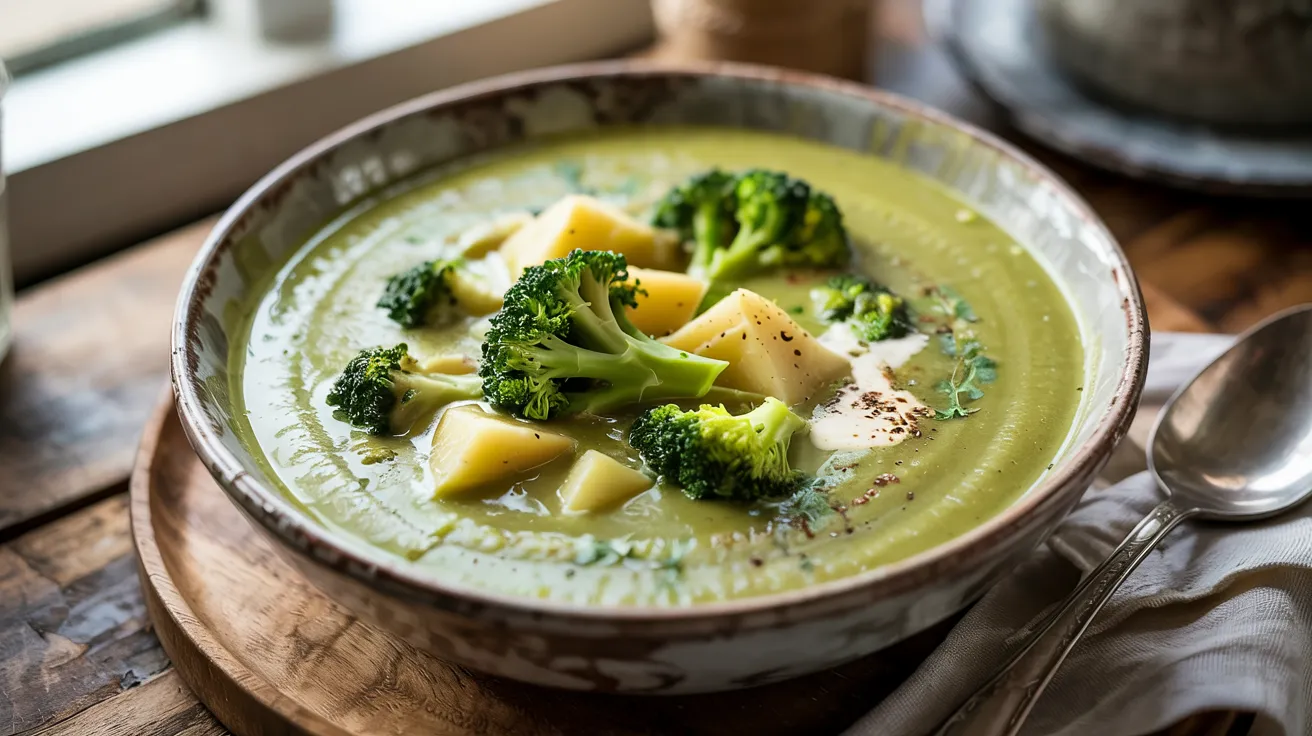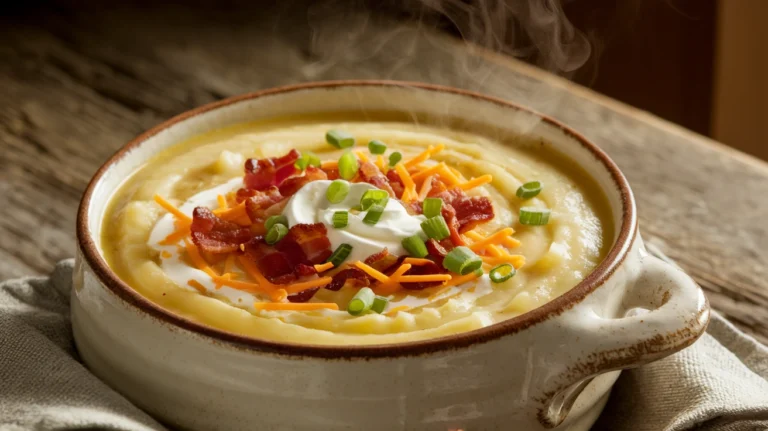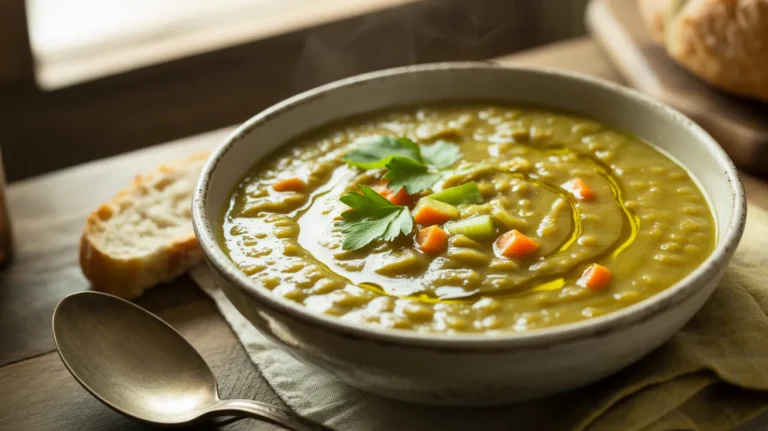This hearty broccoli and potato soup delivers restaurant-quality comfort in your own kitchen with simple, wholesome ingredients. Our detailed broccoli and potato soup recipe walks complete beginners through every step to create a perfectly creamy, flavorful soup that serves four people generously.
SERVES: 4 | PREP: 20 MIN | COOK: 25 MIN | TOTAL: 45 MIN
Ingredients for Perfect Broccoli and Potato Soup
Base Vegetables
| Ingredient | Amount | Notes |
|---|---|---|
| Medium potatoes | 3 large (about 2 lbs) | Yukon Gold or Russet work best |
| Fresh broccoli | 1 large head (1.5 lbs) | Cut into uniform florets |
| Yellow onion | 1 medium | Diced fine for smooth texture |
| Garlic cloves | 3 large | Minced fresh |
Liquid & Seasonings
| Ingredient | Amount | Purpose |
|---|---|---|
| Vegetable broth | 4 cups | Low-sodium preferred |
| Heavy cream | 1 cup | Creates silky richness |
| Butter | 3 tablespoons | For sautéing base |
| Salt | 1 teaspoon | Adjust to taste |
| Black pepper | ½ teaspoon | Freshly ground |
| Bay leaves | 2 whole | Remove before serving |
Complete Step-by-Step Broccoli and Potato Soup Instructions
Phase 1: Vegetable Preparation (10 minutes)
Step 1: Prepare Your Potatoes (4 minutes) Start by washing 3 large potatoes under cold running water, scrubbing away any dirt with your hands or a vegetable brush. Using a sharp peeler, remove all the skin by peeling away from your body in long strips—this prevents accidents. Rinse the peeled potatoes again. On a clean cutting board, cut each potato in half lengthwise, then cut each half into 1-inch cubes. Why this size? Uniform 1-inch pieces cook evenly in about 12 minutes and are perfect for partial blending later. Place the cubed potatoes in a bowl of cold water to prevent browning while you prep other ingredients.
Step 2: Prepare Fresh Broccoli (4 minutes) Take your large broccoli head and examine it—you want bright green color with no yellow spots. Using a sharp knife, cut the florets away from the main stalk by slicing where each floret naturally separates. Aim for bite-sized pieces about 1½ inches across—larger pieces won’t cook evenly, smaller pieces turn mushy. Don’t waste the tender inner stem! Peel the tough outer skin with your knife, then dice the tender center into small pieces. This adds extra flavor and nutrition to your broccoli and potato soup. Set all broccoli pieces aside in a separate bowl.
Step 3: Dice the Onion Properly (2 minutes) Peel your medium onion and cut it in half from top to bottom (through the root end). Lay each half flat-side down on your cutting board for stability. Make horizontal cuts toward the root end, stopping about ½ inch before the root (this holds the onion together). Then make vertical cuts from top to bottom, creating a grid pattern. Finally, slice across the grain to create uniform small dice. Why so detailed? Properly diced onion melts into the soup base, creating sweetness without chunky texture that beginners often struggle with.
Phase 2: Building the Aromatic Base (8 minutes)
Step 4: Heat Your Pot Correctly (1 minute) Choose a heavy-bottomed pot that holds at least 4 quarts—this prevents scorching and hot spots. Place it on your stove over medium heat (about 5 on a scale of 1-10). Add 3 tablespoons of butter and watch it carefully. You’ll see it melt, then foam up, then the foaming will subside. This takes about 60 seconds. When the foaming stops, your butter is ready—this prevents the vegetables from sticking and adds rich flavor to your broccoli and potato soup base.
Step 5: Cook the Onion Foundation (5 minutes) Add your diced onion to the melted butter and stir immediately to coat every piece. You should hear a gentle sizzling—if it’s violent, reduce heat to medium-low. Stir the onion every 30 seconds for the first 2 minutes, then every minute after that. Watch for these visual cues: first the onion will look raw and white, then it becomes translucent (you can almost see through it), and finally it softens completely. This takes 4-5 minutes total. Don’t rush by increasing heat—burned onion tastes bitter and ruins the entire soup.
Step 6: Add Garlic at the Right Time (30 seconds) Using a garlic press or sharp knife, mince 3 large garlic cloves into tiny pieces—no chunks should be visible. Add the minced garlic to your translucent onions and stir constantly for exactly 30 seconds. You’ll smell an amazing aroma when the garlic is ready. Why such precise timing? Garlic cooks incredibly fast and burns easily. Burned garlic tastes harsh and bitter, but properly cooked garlic adds deep, sweet flavor to your soup base.
Phase 3: Building the Soup Foundation (3 minutes)
Step 7: Add Potatoes to the Base (1 minute) Drain your cubed potatoes from the cold water and pat them dry with paper towels—wet potatoes can cause dangerous splattering when they hit hot butter. Add all the potato cubes to your pot and stir gently to coat each piece with the aromatic butter mixture. You’ll hear increased sizzling as the potatoes release their moisture. Stir for about 60 seconds until every potato piece is coated—this step helps them cook evenly and prevents sticking to the pot bottom.
Step 8: Add Liquid and Seasonings (2 minutes) Pour in all 4 cups of vegetable broth slowly to prevent splashing. The liquid should cover your potatoes by about 1 inch—if not, add warm water until they’re covered. Drop in 2 whole bay leaves (don’t break them, or you’ll have small pieces to fish out later). Add 1 teaspoon of salt and ½ teaspoon of freshly ground black pepper. Stir everything together gently with a wooden spoon. Why wooden? It won’t scratch your pot or conduct heat like metal spoons do.
Phase 4: First Cooking Stage (12 minutes)
Step 9: Bring to a Proper Boil (3 minutes) Increase heat to medium-high and watch your soup carefully. You’ll see small bubbles forming on the bottom first, then larger bubbles rising to the surface. A full rolling boil means large bubbles are constantly breaking the surface across the entire pot. This usually takes 2-3 minutes depending on your stove. Don’t walk away during this step—you need to catch the moment it boils to adjust the heat immediately.
Step 10: Reduce to Perfect Simmer (9 minutes) The moment your broccoli and potato soup reaches a rolling boil, immediately reduce heat to low or medium-low. You want a gentle simmer—small bubbles occasionally breaking the surface, not a violent boil that could break apart your potatoes. Place the lid on the pot, but leave it slightly askew (about 1 inch gap) to prevent over-boiling while allowing some evaporation. Set a timer for 12 minutes and resist the urge to stir constantly—gentle simmering does the work.
Step 11: Test Potato Doneness (1 minute) After 12 minutes, remove the lid carefully (steam will escape) and test a potato piece with a sharp knife or fork. The knife should slide through easily with no resistance, but the potato shouldn’t fall apart or look mushy. If there’s still resistance, continue simmering for 2-3 more minutes and test again. Properly cooked potatoes are crucial—undercooked potatoes won’t blend smoothly, while overcooked potatoes make the soup gluey.
Phase 5: Adding Broccoli (8 minutes)
Step 12: Add Broccoli at the Right Time (1 minute) Add all your prepared broccoli florets and diced stem pieces to the simmering soup. Stir gently once to distribute them evenly. Don’t stir aggressively—you want to avoid breaking the tender potato pieces. The broccoli will initially float on top, then gradually sink as it cooks. Fresh broccoli maintains better color and texture than frozen, which is why we use it in this broccoli and potato soup recipe.
Step 13: Cook Broccoli to Perfection (6-7 minutes) Continue simmering uncovered for 6-8 minutes. Watch the broccoli color change from dark green to bright, vibrant green—this indicates perfect doneness. Overcooked broccoli turns grayish-green and becomes mushy with an unpleasant sulfur smell. Test a floret with your spoon—it should be tender-crisp, yielding to gentle pressure but not falling apart. The stem pieces should be completely tender since they take longer to cook than florets.
Step 14: Remove Bay Leaves Safely (1 minute) Using tongs or a slotted spoon, carefully locate and remove both bay leaves from your soup. Bay leaves can be tricky to spot among the vegetables, so search systematically around the pot edges where they often float. If a bay leaf breaks apart, remove all pieces—they’re not digestible and taste bitter if accidentally eaten. This step is crucial for food safety and eating enjoyment.
Phase 6: Creating the Perfect Texture (5 minutes)
Step 15: Blend for Ideal Consistency (2 minutes) Remove the pot from heat completely before blending—this prevents dangerous splattering. Using an immersion blender (stick blender), insert it into the soup and blend in short 10-15 second bursts, moving it around the pot. Blend about 60% of the soup, leaving visible chunks of potato and broccoli for texture. If you don’t have an immersion blender, carefully transfer half the soup to a regular blender, blend until smooth, then return it to the pot. Never blend hot soup in a regular blender without removing the center cap and covering with a towel—pressure buildup can cause dangerous explosions.
Step 16: Add Cream Properly (2 minutes) Reduce heat to the lowest setting on your stove. Slowly pour the heavy cream into the soup while stirring constantly with a wooden spoon. Pour in a thin stream, not all at once—this prevents temperature shock that can cause curdling. The soup will immediately become pale and creamy. If you see any lumps or separation, remove from heat immediately and whisk vigorously until smooth.
Step 17: Final Seasoning (1 minute) Taste your broccoli and potato soup carefully (blow on the spoon first—it’s hot!). Start by adding more salt in small pinches, tasting after each addition. Potatoes absorb lots of salt, so you might need more than expected. Add freshly ground black pepper to taste. The soup should taste rich, creamy, and well-balanced. If it tastes flat, add a squeeze of fresh lemon juice to brighten the flavors.
Phase 7: Final Touches (2 minutes)
Step 18: Final Simmer and Serve (2 minutes) Return the soup to the lowest possible heat and let it warm through for 2-3 minutes, stirring occasionally. Don’t let it boil after adding cream—this can cause curdling. The soup is ready when it’s steaming hot throughout and coats the back of your spoon lightly. Ladle into warmed bowls and serve immediately while hot. Garnish with fresh herbs, a drizzle of cream, or a sprinkle of cheese if desired.
Chef’s Notes for Broccoli and Potato Soup Success
Texture Control: For completely smooth soup, blend everything thoroughly and strain through a fine-mesh sieve. For chunky texture, mash only half the potatoes with a fork before adding broccoli.
Flavor Enhancement: Add a splash of white wine with the broth for complexity, or stir in fresh lemon juice just before serving to brighten the overall taste profile.
Consistency Adjustments: If your broccoli and potato soup becomes too thick, thin with additional warm broth. If too thin, simmer uncovered for 5-10 minutes to concentrate flavors through evaporation.
Make-Ahead Benefits: This soup tastes even better the next day as flavors meld and develop. Cool completely before refrigerating to maintain food safety standards.
Nutrition Per Serving
- Calories: 285
- Protein: 8g
- Carbohydrates: 32g
- Fat: 15g
- Fiber: 5g
- Sodium: 650mg
Creative Broccoli and Potato Soup Variations
Cheesy Version: Stir in 1 cup sharp cheddar cheese after adding cream. Remove from heat and whisk until melted smooth—similar to our creamy potato garlic soup technique for rich, indulgent results.
Spiced Alternative: Add curry powder, cumin, and fresh ginger for an Indian-inspired twist, much like our curry soup with chickpeas and potatoes for warming, aromatic spices.
Protein-Enhanced: Add cooked bacon bits, diced ham, or shredded rotisserie chicken in the final 5 minutes for a heartier, more substantial meal.
Vegan Option: Replace butter with olive oil and heavy cream with full-fat coconut milk. Use vegetable broth and add nutritional yeast for umami depth and cheesy flavor.
Storage & Reheating Your Broccoli and Potato Soup
Refrigerator Storage: Store covered for up to 4 days. The soup will naturally thicken—thin with additional broth when reheating for optimal consistency.
Freezer Storage: Freeze for up to 3 months in freezer-safe containers. Leave 2 inches headspace for expansion during freezing process.
Reheating Methods: Warm gently over low heat, stirring frequently to prevent scorching. Add splash of cream or broth if needed. Microwave individual portions for 1-2 minutes, stirring halfway through heating.

Troubleshooting Common Broccoli and Potato Soup Problems
Watery Consistency: Simmer uncovered for 10-15 minutes to evaporate excess liquid, or whisk in a slurry of 2 tablespoons flour mixed with cold water for immediate thickening.
Curdled Cream: This happens when cream meets high heat. Remove from heat immediately, whisk vigorously, and add a splash of cold cream to restore smooth texture.
Bland Flavor Profile: Increase salt gradually—potatoes absorb significant seasoning. Add a splash of lemon juice or white wine vinegar to brighten and enhance overall taste.
Overcooked Broccoli: Next time, add florets only in the final 6 minutes of cooking. Frozen broccoli requires just 4 minutes to maintain optimal texture and color.
Overly Thick Texture: Whisk in warm broth or additional cream gradually until you achieve desired consistency. Avoid adding cold liquid as it can cause temperature shock and separation.
Essential Equipment for Perfect Results
- Large heavy-bottomed pot (4-quart minimum capacity)
- Immersion blender or regular blender for smooth texture
- Sharp chef’s knife for clean, uniform vegetable cuts
- Sturdy cutting board with groove for juice collection
- Wooden spoon for stirring without scratching pot surface
- Fine-mesh strainer (optional, for ultra-smooth consistency)
Organized Shopping List
Produce Section
- 3 large potatoes (Yukon Gold preferred for creaminess)
- 1 large head fresh broccoli (bright green, firm florets)
- 1 medium yellow onion (firm, no soft spots)
- 1 head fresh garlic (plump, firm cloves)
Dairy Section
- 1 cup heavy cream (at least 35% fat content)
- 3 tablespoons butter (unsalted preferred)
Pantry/Canned Goods
- 32 oz vegetable broth (low-sodium variety)
- Dried bay leaves (whole, not crushed)
- Fine sea salt and whole black peppercorns
Five Success Secrets for Amazing Broccoli and Potato Soup
1. Perfect Vegetable Prep: Cut all vegetables uniformly so everything cooks at the same rate. Uneven pieces mean some ingredients will be mushy while others remain undercooked and hard.
2. Proper Base Development: Never skip the onion-cooking step—properly softened onions create the essential flavor foundation that elevates homemade broccoli and potato soup to restaurant quality.
3. Season Throughout Process: Taste and adjust seasoning at every major step, not just at the end. Building layers of flavor throughout cooking creates more complex, deeply satisfying results.
4. Temperature Control: Maintain careful heat management when adding cream to prevent curdling. Low, gentle heat maintains the silky, luxurious texture that makes this soup special.
5. Serve Fresh and Hot: This broccoli and potato soup is meant to be enjoyed immediately while steaming hot. The flavors are brightest and the texture is optimal when served fresh from the pot.




